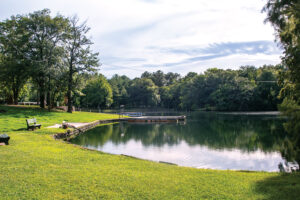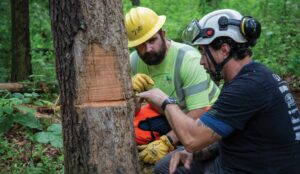More than 200 years of farming history will come to life on March 25 when the McLean County Museum of History opens its newest exhibit – Challenges, Choices and Change: Farming in the Great Corn Belt. The permanent exhibit housed in the Franklin Family Gallery has been almost four years in the making and will feature artifacts, images, video, digital interactives, and hands-on activities to connect visitors to McLean County’s rich farming and agricultural history.
Guest Curator Don Meyer and Museum Curator Susan Hartzold collaborated on the unique exhibit that tells the story of farming as it has been done by McLean County farmers through the generations. Meyer is a veteran McLean County agricultural extension adviser and lecturer at Illinois State University’s Department of Agriculture and grew up on a farm. Likewise, Hartzold was raised on a farm, and both are passionate about telling the farm story.
“It was very important for us to tell McLean County’s own farming story, so a tremendous amount of time and effort went into identifying images, experiences and stories of farmers across the area,” says Hartzold. “The result is that we are able to reveal the difficult choices they had to make in order to be productive and profitable.”
Some of the biggest challenges to a project of this magnitude were finding the people who could tell those personal stories, and how to condense 200 years of photographs, stories and farming equipment into the available space. “There was so much we wanted to explore,” says Meyer. “One of the biggest challenges was finding the people who could help us tell the story, and that is what has made it unique.”
The problem was solved through the use of technology that includes hands-on and digital interactives to engage visitors. The museum’s Digital Humanities Curator Torii More’ helped Hartzold define how technology could be used to show large equipment and explain sophisticated concepts while being efficient with the gallery’s limited space. The exhibit’s main focus is the story of farmers and how they made it work, not the crops and equipment.
In the early 1800s, when the first European farmers settled in McLean County, the land had been farmed for thousands of years by native people. The Illinois prairie was rich, but extremely difficult to break, and parts of it were swampy. Farmers had to work smart and learn how to get the most out of the land. As time changed so did tiling, tilling, fertilization and everything needed to make the land as productive as possible, while being good stewards of it.
The exhibit also shows how the Farm Bureau helped improve the lives of farmers including the creation of agriculture-specific organizations, and explains the important role farm wives played.
And, as time passed, shifting markets and economic forces have dramatically changed what McLean County farmers produce, and where and how those commodities reach the markets. The exhibit will explore innovations from draining fields and equipment to Funk Brothers hybrid seed and the conditions that led to today’s two-crop commodities of corn and soybeans.
The exhibit is divided into six themes: Our Rich Land, Working the Land, Marketing Crops and Livestock, Nature’s Forces, Farmers Resources, and Cost of Farming. It spans from the early pioneer period, after the railroads, the turn of the century to World War II, and on to the year 2000. There is also a small theatre housed in an authentic grain bin with antique tractor seats.
Although the museum is located in McLean County, Hartzold points out that this is really the story of farming in the Midwest. For more information about the exhibit, hours and admission, visit www.mchistory.org.










